Ontario, California, Hgh State Clinic, Hgh Injections, Hrt Doctors
Ontario, California Blood Testing Facilities
 Represents a LabCorp blood testing facility
Represents a LabCorp blood testing facility Represents a Quest Diagnostics blood testing facility
Represents a Quest Diagnostics blood testing facility

Nearby Labcorp Blood Testing facilities:
- Labcorp Center Distance: 2 m, 1310 San Bernardino Rd Ste 107, Upland, San Bernardino County, CA, 91786
- Labcorp Center Distance: 3 m, 8283 Grove Ave Ste 109, Rancho Cucamonga, San Bernardino County, CA, 91730
- Labcorp Center Distance: 5 m, 10801 Foothill Blvd Ste 105, Rancho Cucamonga, San Bernardino County, CA, 91730
- Labcorp Center Distance: 10 m, 1335 Cypress Ave. Suite 101, San Dimas, Los Angeles County, CA, 91773
- Labcorp Center Distance: 13 m, 900 S. Main St. Suite 207, Corona, Riverside County, CA, 92882
- Labcorp Center Distance: 14 m, 420 W. Rowland Street, Covina, Los Angeles County, CA, 91722
- Labcorp Center Distance: 15 m, 3975 Jackson St. Ste 104, Riverside, Riverside County, CA, 92503
- Labcorp Center Distance: 16 m, 6927 Brockton Ave Ste 1B, Riverside, Riverside County, CA, 92506
- Labcorp Center Distance: 19 m, 1950 Sunnycrest Dr. Suite 1800, Fullerton, Orange County, CA, 92835
- Labcorp Center Distance: 21 m, 399 E. Highland Ave. Ste 510, San Bernardino, San Bernardino County, CA, 92404
- Labcorp Center Distance: 22 m, 705 W La Veta Ave Ste 102, Orange, Orange County, CA, 92868
- Labcorp Center Distance: 23 m, 622 W. Duarte Rd. Suite 303, Arcadia, Los Angeles County, CA, 91007
- Labcorp Center Distance: 24 m, 12712 Heacock St. Ste 7, Moreno Valley, Riverside County, CA, 92553
- Labcorp Center Distance: 25 m, 255 Terracina Blvd Ste 106, Redlands, San Bernardino County, CA, 92373
- Labcorp Center Distance: 26 m, 3400 W. Ball Road Ste 104, Anaheim, Orange County, CA, 92804
- Labcorp Center Distance: 27 m, 4870 Barranca Pkwy. Ste 290, Irvine, Orange County, CA, 92604
- Labcorp Center Distance: 28 m, 15064 Moran Street, Westminster, Orange County, CA, 92683
- Labcorp Center Distance: 29 m, 126 Avocado Ave. Ste 105, Perris, Riverside County, CA, 92571
- Labcorp Center Distance: 31 m, 23961 Calle De La Magdalena St, Laguna Hills, Orange County, CA, 92653
- Labcorp Center Distance: 32 m, 17450 Main St. Suite C, Hesperia, San Bernardino County, CA, 92345
- Labcorp Center Distance: 33 m, 31571 Canyon Estates Dr Ste101, Lake Elsinore, Riverside County, CA, 92532
- Labcorp Center Distance: 34 m, 34845 Yucaipa Bl. Ste B, Yucaipa, San Bernardino County, CA, 92399
- Labcorp Center Distance: 35 m, 12332 Hesperia Rd Suite B, Victorville, San Bernardino County, CA, 92395
- Labcorp Center Distance: 36 m, 19341 Bear Valley Rd Ste 102, Apple Valley, San Bernardino County, CA, 92308
- Labcorp Center Distance: 37 m, 29798 Haun Rd Ste 102, Menifee, Riverside County, CA, 92586
- Labcorp Center Distance: 39 m, 16008 Kamana Dr. Suite 201, Apple Valley, San Bernardino County, CA, 92307
- Labcorp Center Distance: 40 m, 36320 Inland Valley Dr Ste 103, Wildomar, Riverside County, CA, 92595
- Labcorp Center Distance: 41 m, 665 Camino De Los Mares 303A, San Clemente, Orange County, CA, 92673
- Labcorp Center Distance: 42 m, 38209 47Th St East Suite C, Palmdale, Los Angeles County, CA, 93552
- Labcorp Center Distance: 43 m, 25405 Hancock Ave. Suite 107, Murrieta, Riverside County, CA, 92562
- Labcorp Center Distance: 44 m, 850 E. Latham Ave. Ste Cd, Hemet, Riverside County, CA, 92544
- Labcorp Center Distance: 45 m, 627 West Ave Q Suite B, Palmdale, Los Angeles County, CA, 93551
- Labcorp Center Distance: 46 m, 550 Deep Valley Dr. Suite 317, Palos Verdes Estates, Los Angeles County, CA, 90274
- Labcorp Center Distance: 47 m, 27699 Jefferson Ave Ste 209, Temecula, Riverside County, CA, 92590
- Labcorp Center Distance: 48 m, 1450 10Th St. Suite 406, Santa Monica, Los Angeles County, CA, 90401
- Labcorp Center Distance: 50 m, 31150 Temecula Parkway Ste 201, Temecula, Riverside County, CA, 92592
- Labcorp Center Distance: 51 m, 18399 Ventura Blvd. Suite 17, Tarzana, Los Angeles County, CA, 91356
- Labcorp Center Distance: 52 m, 587 E. Elder Street, Fallbrook, San Diego County, CA, 92028
- Labcorp Center Distance: 55 m, 23206 Lyons Ave Ste 109, Newhall, Los Angeles County, CA, 91321
- Labcorp Center Distance: 56 m, 7301 Medical Center Dr Ste 304, West Hills, Los Angeles County, CA, 91307
- Labcorp Center Distance: 57 m, 25775 Mcbean Pkway. Suite 102, Valencia, Los Angeles County, CA, 91355
- Labcorp Center Distance: 58 m, 27420 Tourney Rd. Suite 140, Valencia, Los Angeles County, CA, 91355
- Labcorp Center Distance: 62 m, 28240 Agoura Road Suite 204, Agoura Hills, Los Angeles County, CA, 91301
- Labcorp Center Distance: 64 m, 2067 West Vista Way Suite 275, Vista, San Diego County, CA, 92083
- Labcorp Center Distance: 65 m, 555 E. Tachevah Dr. Suite 3E, Palm Springs, Riverside County, CA, 92262
- Labcorp Center Distance: 66 m, 2655 First St. Suite 340, Simi Valley, Ventura County, CA, 93065
- Labcorp Center Distance: 67 m, 574 E. Virginia Way, Barstow, San Bernardino County, CA, 92311
- Labcorp Center Distance: 68 m, 1595 Grand Ave Ste 109, San Marcos, San Diego County, CA, 92078
- Labcorp Center Distance: 70 m, 425 Haaland Dr. Ste 106, Thousand Oaks, Ventura County, CA, 91361
- Labcorp Center Distance: 71 m, 865 Patriot Drive Suite 101, Moorpark, Ventura County, CA, 93021
- Labcorp Center Distance: 72 m, 558 N. Ventu Park Rd. Suite C, Newbury Park, Ventura County, CA, 91320
Nearby Quest Blood Testing facilities:
- Quest Center Distance: 3 m, 1399 E Foothill Blvd, Upland, San Bernardino County, CA, 91786-4060
- Quest Center Distance: 5 m, 4028 Grand Ave, Chino, San Bernardino County, CA, 91710-5486
- Quest Center Distance: 13 m, 118 W 9Th St, Corona, Riverside County, CA, 92882-3320
- Quest Center Distance: 14 m, 2250 S. Main St, Corona, Riverside County, CA, 92882-2534
- Quest Center Distance: 15 m, 9041 Magnolia Ave, Riverside, Riverside County, CA, 92503-3956
- Quest Center Distance: 16 m, 4646 Brockton Ave, Riverside, Riverside County, CA, 92506-0103
- Quest Center Distance: 21 m, 2150 N Waterman Ave, San Bernardino, San Bernardino County, CA, 92404-4811
- Quest Center Distance: 22 m, 1310 W Stewart Dr, Orange, Orange County, CA, 92868-3838
- Quest Center Distance: 23 m, 6485 Day St, Riverside, Riverside County, CA, 92507-0926
- Quest Center Distance: 26 m, 416 W Lastunas Dr, San Gabriel, Los Angeles County, CA, 91776-1236
- Quest Center Distance: 27 m, 4950 Barranca Pkwy, Irvine, Orange County, CA, 92604-8648
- Quest Center Distance: 28 m, 11180 E Warner Ave, Fountain Valley, Orange County, CA, 92708-7515
- Quest Center Distance: 30 m, 9900 Talbert Ave, Fountain Valley, Orange County, CA, 92708-5153
- Quest Center Distance: 31 m, 23521 Paseo De Valencia, Laguna Hills, Orange County, CA, 92653-3673
- Quest Center Distance: 32 m, 18800 Main St, Huntington Beach, Orange County, CA, 92648-1718
- Quest Center Distance: 33 m, 420 E 3Rd St, Los Angeles, Los Angeles County, CA, 90013-1646
- Quest Center Distance: 34 m, 32251 Mission Trl, Lake Elsinore, Riverside County, CA, 92530-4536
- Quest Center Distance: 35 m, 12370 Hesperia Rd, Victorville, San Bernardino County, CA, 92395-4787
- Quest Center Distance: 41 m, 8501 Wilshire Blvd, Beverly Hills, Los Angeles County, CA, 90211-3117
- Quest Center Distance: 43 m, 23441 Madison St, Torrance, Los Angeles County, CA, 90505-4735
- Quest Center Distance: 44 m, 520 N Prospect Ave, Redondo Beach, Los Angeles County, CA, 90277-3043
- Quest Center Distance: 47 m, 27699 Jefferson Ave, Temecula, Riverside County, CA, 92590-2696
- Quest Center Distance: 51 m, 18250 Roscoe Blvd, Northridge, Los Angeles County, CA, 91325-4265
- Quest Center Distance: 63 m, 3601 Vista Way, Oceanside, San Diego County, CA, 92056-4559
- Quest Center Distance: 64 m, 2876 Sycamore Dr, Simi Valley, Ventura County, CA, 93065-1550
- Quest Center Distance: 65 m, 555 E Tachevah Dr, Palm Springs, Riverside County, CA, 92262-5750
- Quest Center Distance: 67 m, 1220 La Venta Dr., Westlake Village, Ventura County, CA, 91361-3749
- Quest Center Distance: 70 m, 57370 29 Palms Hwy, Yucca Valley, San Bernardino County, CA, 92284-2900
- Quest Center Distance: 72 m, 477 N El Camino Real, Encinitas, San Diego County, CA, 92024-1353
- Quest Center Distance: 81 m, 500 Paseo Camarillo, Camarillo, Ventura County, CA, 93010-5900
- Quest Center Distance: 84 m, 81715 Dr Carreon Blvd, Indio, Riverside County, CA, 92201-5564
- Quest Center Distance: 86 m, 807D Tucker Rd, Tehachapi, Kern County, CA, 93561-2510
- Quest Center Distance: 96 m, 5103 Garfield St, La Mesa, San Diego County, CA, 91941-5103
California Hormone Replacement Therapy Services
Hormone Imbalance is a significant medical issue that many people don't consider as thoughtfully as they should. Do you feel that your body and mind are slowing down as you grow older, and do you want to do something about it?
The Conscious Evolution Institute can quickly and discreetly provide you with Physician-Monitored Hormone Replacement Therapy Solutions. We offer a number of plans and programs which have been proven to help improve the lives and wellness of millions across the United States and the World.
Testosterone Therapy in California
As we grow older, our hormone levels start to decline naturally as a result of age. Starting around the age of thirty, men can start to suffer from a decline in physical and sexual health resulting directly from Low-T. If you are experiencing a lack of sex drive or symptoms of Erectile Dysfunction, this could be the tip of the iceberg of a number of different medical problems which can have a significantly negative impact on your health and longevity.
Testosterone Deficiency can even impact female health! Especially in the areas of sexual and cardiovascular health.
HGH Replacement in California
Like Testosterone, Growth Hormone Levels also start to decline with age, to the great detriment of our health. HGH sustains the cellular metabolism of the body, feeding us energy and allowing our bodies to rebuild and rehabilitate. As HGH Levels drop, our body goes into physiological decline because it simply can't keep up with the demands of day-to-day life.
Bio-Identical Growth Hormone Injections can restore healthy adult HGH concentrations, giving the body the raw resources needed to amplify health and wellness and preserve the human body from the effects of premature aging.
Sermorelin Injections in California
Sermorelin is an alternative to Human Growth Hormone, which fulfills the same goal of mitigating the effects of Growth Hormone Deficiency. Rather than replace HGH directly, Sermorelin Acetate stimulates the body to produce more of this precious hormone, while the body still has the ability to regulate HGH Release to make sure that the body gets the optimal level of Growth Hormone.
California HCG Diet
For men and women that are looking for a way to effectively and quickly lose weight, the Conscious Evolution Institute offers HCG Injection Therapy, which, when combined with an effective and specifically-designed diet, encourages the body to rapidly burn fat while sustaining energy and limiting the sensation of hunger, making dieting much more manageable.
Major Metropolitan Areas of California
Los Angeles
Los Angeles California, also known as Tinseltown, the City of Angels, or simply L.A., is the largest metropolitan area in the state of California. The city is known for having a near-insurpassable level of glitz and glamor, and the city is probably most widely known around the world for Hollywood, the center of the global film world, where actors and directors come together to produce films with the largest budgets the world has ever seen.
The L.A. Metro is home to a number of different professional sports teams, such as the L.A. Lakers, the L.A. Clippers, and the Los Angeles Angels of Anaheim. Los Angeles is also home to the Dodgers, who moved to California from Brooklyn, New York in 1957.
San Francisco
San Francisco is widely considered one of the most unique cities in the United States, and is the second largest city in the state of California. In terms of raw diversity, there is probably no place in the United States more diverse than San Francisco, except for Queens New York. The culture of San Francisco is highly politically active and people aren't afraid to voice their concerns under any circumstances.
The city is also home to a number of pro sports teams including the San Francisco 49ers and the Giants. The Oakland Raiders, Golden State Warriors, and Oakland As play just across the San Francisco Bay. The most famous place in San Francisco is, by far, the Golden Gate Bridge, which connects San Francisco to the Golden Gate Recreational Area to the north of the city.
San Diego
San Diego is the third largest metro in the state of California, and is the furthest south of all of the major cities in the state, immediately bordering Mexico to the south. Immediately south of San Diego is Tijuana, Mexico, and beyond that is Baja California.
San Diego's economy is driven heavily by its United States Military Presence and its busy deep-water harbor. San Diego is actually the only city on the west coast which has a shipyard which builds military ships and submarines. San Diego is home to two professional sports teams, the San Diego Padres and the Chargers.
Riverside
Riverside is the largest inland metro area in California, and the fourth largest in the state. Although Riverside itself is relatively small in comparison to the other, larger cities of the state, Riverside is the key city in a highly populated region known as the Inland Empire. Other major cities include San Bernadino and Ontario, California.
Unlike most major metros in the state and the country, the Inland Empire represents a large number of cities that grew close and simultaneously, and Riverside also belongs to a census area known as the Greater Los Angeles Area, one of the largest in the country with more than 7 million people.
Sacramento
Sacramento is the fifth largest metro area in the state of California and is located inland about 85 miles northeast of San Francisco. The city is also the capital of California. Like San Francisco, Sacramento is hailed as a highly diverse city, and is frequently recognized as one of the most well-integrated cities in the United States.
Sacramento is home to a single professional sports team, the Sacramento Kings. The city also has a highly active rock culture, contributing artists such as Cake and the Deftones to the national scene. The city also has a large theatrical scene, including the Sacramento Ballet, the B-Street Theater, and the Sacramento Shakespeare Festival.
All About Ontario, California Geographic Area
Ontario is a city located in south west San Bernardino County, California, United States, 35 miles east of downtown Los Angeles. Located in the western part of the Inland Empire region, it lies just east of the Los Angeles county line and is part of the Greater Los Angeles Area. As of the 2010 Census, the city had a population of 163,924, down from 170,373 at the 2000 census, making it the county's fourth most populous city after San Bernardino, Fontana, and Rancho Cucamonga.
The city is home to the LA/Ontario International Airport which is the 15th busiest cargo airport in the United States. Ontario handles the mass of freight traffic between the ports of Los Angeles and Long Beach and the rest of the country. It is also the home of Ontario Mills and former home of the Ontario Motor Speedway.
It takes its name from the Ontario Model Colony development established in 1882 by the Canadian engineer George Chaffey and his brothers William Chaffey and Charles Chaffey. They named the settlement after their home province of Ontario, Canada.
The area that is now Ontario was part of the lands used for hunting and foraging by the semi-nomadic Tongva Serrano (GabrieleR±o) Indians, who were known to roam as far south as the western San Bernardino Mountains. At the time of Mexican and later of American settlement, active Native American settlements were scattered across the entire valley. Remains of a Serrano village were discovered in the neighboring foothills of the present-day city of Claremont.
Juan Bautista de Anza friend of the land owner of Rancho Cucamonga [located at Township 1 South Range 7 West], Tiburcio Tapia, leaving him the assistance of the Cahuilla Indians from Anza, whom were under no control of any Spanish establishments. Other than the street and middle school named after De Anza, the only other artifact representing this expedition of De Anza and the Cahullia Tribe is a structure (still standing at 1007 East Main Street in the city's current Quiet Home Acquisition Project Area) and is not currently recognized for its significance. Following the 1819 establishment of San Bernardino Asistencia, which may have served as an outpost of the San Gabriel mission, it became part of a large, vaguely identified area called "San Antonio".
In 1826, Jedediah Smith passed through what is now Upland on the first overland journey to the West coast of North America via the National Old Trails Highway (present-day Foothill Blvd).
The 1834 secularization of California land holdings resulted in the land's transferral to private hands. In 1881, the Chaffey brothers George and William purchased the land (which at that time also included the present-day city of Upland) and the water rights to it. They engineered a drainage system channeling water from the foothills of Mount Baldy down to the flatter lands below that performed the dual functions of allowing farmers to water their crops and preventing the floods that periodically afflict them. They also created the main thoroughfare of Euclid Avenue (California Highway 83), with its distinctive wide lanes and grassy median. The new "Model Colony" (called so because it offered the perfect balance between agriculture and the urban comforts of schools, churches, and commerce) was originally conceived as a dry town, early deeds containing clauses forbidding the manufacture or sale of alcoholic beverages within the town. The two named the town "Ontario" in honor of the province of Ontario in Canada, where they were born.
Ontario attracted farmers (primarily citrus) and ailing Easterners seeking a drier climate. To impress visitors and potential settlers with the "abundance" of water in Ontario, a fountain was placed at the Southern Pacific railway station. It was turned on when passenger trains were approaching and frugally turned off again after their departure. The original "Chaffey fountain," a simple spigot surrounded by a ring of white stones, was later replaced by the more ornate "Frankish Fountain," an Art Nouveau creation now located outside the Ontario Museum of History and Art.
Agriculture was vital to the early economy, and many street names recall this legacy. The Sunkist plant also remains as a living vestige of the citrus era. The Chaffey brothers left to found the settlements of Mildura, Australia and Renmark, Australia which met with varying success. Charles Frankish continued their work at Ontario.
Mining engineer John Tays refined the design of the novel "mule car," used from 1887 for public transportation on Euclid Avenue to 24th Street. At that point, the two mules were loaded onto a platform at the rear of the car and allowed to ride, as gravity propelled the trolley back down the avenue to the downtown Ontario terminus. Soon replaced by an electric streetcar, the mule car is commemorated by a replica in an enclosure south of C Street on the Euclid Avenue median.
Ontario was incorporated as a city in 1891, and North Ontario broke away in 1906, calling itself Upland. Ontario grew at an astronomical rate, increasing 10 times in the next half a century. The population of 20,000 in the 1960s again grew 10 times more by the year 2007. Ontario was viewed as an "Iowa under Palm trees," with a solid Midwestern/Mid-American foundation, but it had a large German and Swiss community. Tens of thousands of European immigrants came to work in agriculture, and in the early 1900s the first Filipinos and Japanese farm laborers arrived, later to display nursery ownership skills.
Ontario has over two centuries of Hispanic residents, starting from the Californio period of Spanish colonial and Mexican rule in the 1840s. However, the first wave of Mexican settlers was in the 1880s brought as workers in the railroad industry (see traquero) and another wave from the Mexican Revolution of the 1910s. Mexican Americans resided in the city's poorer central side facing State Route 60 and Chino.
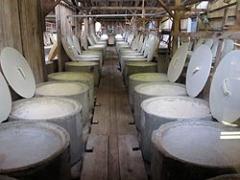
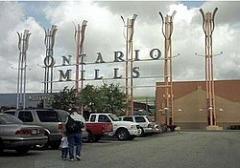
In the years following Ontario's founding, the economy was driven by its reputation as a health resort. Shortly thereafter, citrus farmers began taking advantage of Ontario's rocky soil to plant lemon and orange groves. Agricultural opportunities also attracted vintners and olive growers. The Graber Olive House, which continues to produce olives, is a city historical landmark and one of the oldest institutions in Ontario. Dairy farming is also prevalent, as it continues to be in neighboring Chino.
A major pre-war industry was the city's General Electric plant that produced clothing irons. During and after World War II, Ontario experienced a housing boom common to many suburbs. The expansion of the Southern California defense industry attracted many settlers to the city.
Today, Ontario still has a manufacturing industry, the most notable of which is the Maglite corporation, which produces flashlights there. However, manufacturing has waned, and today Ontario's economy is dominated by service industries and warehousing. Much of southern Ontario still contains dairy farms and other agricultural farms. However, the area is currently under planning to be developed into a mixed-use area of residential homes, industrial and business parks, and town centers, collectively known as the New Model Colony.
Ontario is also home to clothing companies Famous Stars and Straps and Shiekh Shoes, and to Phoenix Motorcars, who employs over 150 employees in Ontario.
According to the City's 2009 Comprehensive Annual Financial Report, the top employers in the city are:
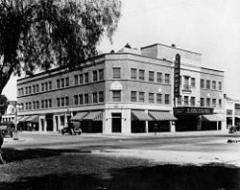
Built in 1925, it was leased to West Coast Junior Theater and by the 1940s was part of Fox West Coast Theater chain. The Granada Theater was designed by noted architect L.A. Smith.

The Citizens Business Bank Arena is a sports arena which opened in late 2008. It is owned by Ontario, but is operated by Anschutz Entertainment Group. It is an 11,000-seat multi-purpose arena, and is home to the Ontario Reign, a team in the ECHL. It is the largest enclosed arena in the Inland Empire.
The first year Los Angeles Kings affiliate plays at the 9,736 -seat Citizens Business Bank Arena. Ontario has posted a respectable 5,207 per game average (5th) in a very crowded southern California entertainment market. Minor league teams often have to build a following with success over time, but Ontario Reign fans have offered strong support of this team right out of the gate.
Ontario was recently announced as the host of the 2010 ECHL Allstar Game. Ontario joins Stockton (2008), Fresno (2006), and Bakersfield (2011) as California franchises hosting the league's midseason showcase. The minor league ASG is expected to pump more than $1 million dollars into the local economy.
Since 1959, Ontario has placed three-dimensional nativity scenes from the life of Jesus on the median of Euclid Avenue during the Christmas season. The scenes, featuring statues by the sculptor Rudolpho Vargas, were challenged in the 1998 as a violation of church-state separation under the California Constitution by atheist resident Patrick Greene, but the dispute was resolved when private organizations began funding the storage and labor involved in the set-up and maintenance of the scenery in its entirety. As means to support the nativity scenes the Ontario Chamber of Commerce started "Christmas on Euclid". This is a craft fair extravaganza is held the first Saturday in December. High end artist/merchants come to sell their creations. The Ontario Rotary also participates in this event by having a classic car show that raises money for the library. Euclid Avenue is closed to traffic from "G" street to Holt for area residents to enjoy shopping for Christmas present and having a delicious meal. In 2009 the Ontario Kiwanis took over management of the event. The All-States Picnic, an Independence Day celebration, began in 1939 to recognize the varied origins of the city's residents. Picnic tables lined the median of Euclid Avenue from Hawthorne to E Street, with signs for each of the country's 48 states. The picnic was suspended during World War II, but when it resumed in 1948, it attracted 120,000 people. A 1941 Ripley's Believe It or Not! cartoon listed Ontario's picnic table as the "world's longest." As native Californians came to outnumber the out-of-state-born, the celebration waned in popularity until it was discontinued in 1981. It was revived in 1991 as a celebration of civic pride. For over 50 years the first Saturday in June the Ontario Kiwanis and the Ontario Rotary partner for the annual "Pancake Breakfast and Car Show". Over 10,000 inland empire resident's come to eat delicious pancakes and view the over 400 cars that come to show off their gorgeous paint jobs and hope appreciate all the hard work they put into the cars.
Ontario is located at 34 °3' North, 117 °38' West (34.05, -117.63).
According to the United States Census Bureau, the city has a total area of 50.0 square miles (129 km2). Of that, 49.9 square miles (129 km2) is land and 0.1 square miles (0.26 km2) is water. The total area is 0.13% water.
The climate of Ontario is semi-arid, with very hot summers and warm winters. Extremes range from 117 F (47 C) to 22 F (-6 C).
After a long period of growth, Ontario showed a population decline between the 2000 and 2010 censuses.
The 2010 United States Census reported that Ontario had a population of 163,924. The population density was 3,278.1 people per square mile (1,265.7/km ²). The racial makeup of Ontario was 83,683 (51.0%) White, 10,561 (6.4%) African American, 1,686 (1.0%) Native American, 8,453 (5.2%) Asian, 514 (0.3%) Pacific Islander, 51,373 (31.3%) from other races, and 7,654 (4.7%) from two or more races. Hispanic or Latino of any race were 113,085 persons (69.0%).
The Census reported that 163,166 people (99.5% of the population) lived in households, 411 (0.3%) lived in non-institutionalized group quarters, and 347 (0.2%) were institutionalized.
There were 44,931 households, out of which 23,076 (51.4%) had children under the age of 18 living in them, 23,789 (52.9%) were opposite-sex married couples living together, 7,916 (17.6%) had a female householder with no husband present, 3,890 (8.7%) had a male householder with no wife present. There were 3,470 (7.7%) unmarried opposite-sex partnerships, and 384 (0.9%) same-sex married couples or partnerships. 6,741 households (15.0%) were made up of individuals and 2,101 (4.7%) had someone living alone who was 65 years of age or older. The average household size was 3.63. There were 35,595 families (79.2% of all households); the average family size was 3.98.
The population was spread out with 49,443 people (30.2%) under the age of 18, 19,296 people (11.8%) aged 18 to 24, 49,428 people (30.2%) aged 25 to 44, 34,703 people (21.2%) aged 45 to 64, and 11,054 people (6.7%) who were 65 years of age or older. The median age was 29.9 years. For every 100 females there were 99.0 males. For every 100 females age 18 and over, there were 96.8 males.
There were 47,449 housing units at an average density of 948.9 per square mile (366.4/km ²), of which 24,832 (55.3%) were owner-occupied, and 20,099 (44.7%) were occupied by renters. The homeowner vacancy rate was 2.0%; the rental vacancy rate was 5.8%. 90,864 people (55.4% of the population) lived in owner-occupied housing units and 72,302 people (44.1%) lived in rental housing units.
As of the census of 2000, there were 158,007 people, 43,525 households, and 34,689 families residing in the city. The population density was 3,173.9 inhabitants per square mile (1,225.5/km ²). There were 45,182 housing units at an average density of 907.6 per square mile (350.4/km ²). The racial makeup of the city was 47.8% White, 7.5% African American, 1.1% Native American, 3.9% Asian, 0.4% Pacific Islander, 34.1% from other races and 5.3% were from two or more races. 59.9% were Hispanic or Latino of any race.
There were 43,525 households out of which 49.4% had children under the age of 18 living with them, 56.9% were married couples living together, 15.5% had a female householder with no husband present, and 20.3% were non-families. 15.1% of all households were made up of individuals and 4.6% had someone living alone who was 65 years of age or older. The average household size was 3.6 and the average family size was 4.0.
In the city the population was spread out with 34.4% under the age of 18, 11.2% from 18 to 24, 32.4% from 25 to 44, 16.1% from 45 to 64, and 5.9% who were 65 years of age or older. The median age was 28 years. For every 100 females there were 100.6 males. For every 100 females age 18 and over, there were 98.7 males.
The median income for a household in the city was $42,452, and the median income for a family was $44,031. Males had a median income of $31,664 versus $26,069 for females. The per capita income for the city was $14,244. 15.5% of the population and 12.2% of families were below the poverty line. 19.1% of those under the age of 18 and 7.6% of those 65 and older were living below the poverty line.
The city is governed by a five-member council: Mayor Paul Leon, who was elected as mayor in 2005, re-elected in November 2006 and is the first Hispanic to serve in that position in the history of Ontario, Mayor pro tem Debra Dorst-Porada, Alan Wapner, Jim Bowman and Sheila Mautz. Councilmembers Bowman and Wapner being the longest tenured members on the council both with 17 years in office. Councilmember Bowman being the only member of the council that is a lifelong resident of Ontario.(66 years)
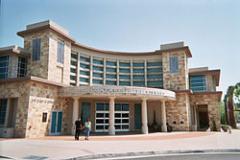
According to the city aos most recent Comprehensive Annual Financial Report, the city's various funds had $399.4 million in revenues, $305.3 million in expenditures, $1,606.0 million in total assets, $317.6 million in total liabilities, and $412.4 million in cash and investments.
The structure of the management and coordination of city services is:
In the state legislature Ontario is located in the 32nd Senate District, represented by Democrat Gloria Negrete McLeod, and in the 61st Assembly District, represented by Democrat Norma Torres. Federally, Ontario is located in California's 43rd congressional district, which has a Cook PVI of D +13 and is represented by Democrat Joe Baca.
Ontario has 25 public elementary schools, six public middle schools and five public high schools under the combined oversight of four school districts. There are also several private schools throughout the city as well as two private military schools. Ontario also has nine trade schools. The University of La Verne College of Law and Chaffey College Ontario Campus are located in downtown Ontario. National University, Argosy University,Ontario and Chapman University have a satellite campus near the Ontario Mills mall.
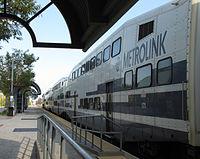
The LA/Ontario International Airport provides domestic and limited international air travel. Because of the many manufacturing companies and warehouses in the city, the airport also serves as a major hub for freight, especially for FedEx and UPS. This airport is owned by the city of Los Angeles.
Because Ontario is a major hub for passengers and freight, the city is also served by several major freeways. Interstate 10 and the Pomona Freeway (State Route 60) run east-west through the city. Interstate 10 is north of the Ontario airport while the Pomona freeway is south of the airport. Interstate 15 runs in the north-south directions at the eastern side of the city. State Route 83, also known as Euclid Avenue, also runs in the north-south direction at the western side of the city.
Ontario also has a Metrolink station off of Haven Avenue. It connects Ontario with much of the Greater Los Angeles area, Orange County and the San Fernando Valley. Public bus transportation is provided by Omnitrans.
The Ontario Mills mall was home to the last Kenny Rogers Roasters operating within the United States. It closed December 31, 2011.
Ontario has five sister cities around the world. They are:
Word Count: 3746







